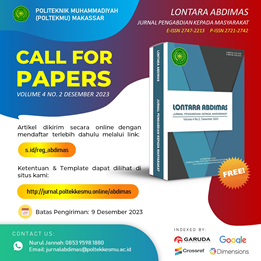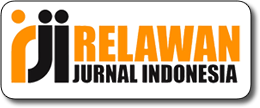LIMBAH SAYURAN REBUNG BAMBU SEBAGAI MIKROORGANISME LOKAL (MOL) DALAM PEMBUATAN PUPUK ORGANIK: Perspektif Pengelolaan Sampah Organik
Abstract
This Community Service Program aims to enhance motivation, knowledge and skills about techniques of producing organic fertilizer from household waste by utilizing local microorganisms (MOL), which can replace agricultural chemicals. Training of using of bamboo shoots vegetable waste, as MOL in the manufacture of organic fertilizer, provides enlightenment in the manufacture of liquid organic fertilizer, and encourages local community businesses independently. MOL contain micro and macro nutrients and bacteria that have the potential to decompose organic matter, stimulate plant growth and act as an activator or decomposer in composting. Organic fertilizers are fertilizers composed of living matter that is processed through a process of decomposition (decomposition) by decomposing bacteria. The method of this community service consists of three phase, namely: 1) the preparation phase, including counseling to the community of Bonto Kio Village, Kec. Minasate'ne, Kab. Pangkep on the using of MOL as liquid organic fertilizer from bamboo shoots vegetable waste; 2) the implementation phase, including direct practice of the material presented; and 3) question and answer or discussion on the use of MOL as organic fertilizer. The results show that this counseling and training success to enhance motivation the community and shows that their level of curiosity and interest in making liquid organic fertilizer using local microorganisms is quite high, such as to increase soil microbes which in turn maintain the fertility of their agricultural land. The community's understanding of the benefits of this activity is very large, as can be seen from the desire to independently make MOL-based organic fertilizers.
References
Asiyah, D. N., R, D. W., Kusumaratih, N. A., & Nur, D. (2015). UNTUK MENGURANGI PENGGUNAAN PUPUK KIMIA DI DESA SERAYU LARANGAN KABUPATEN PURBALINGGA.
Bainbridge, Z., Lewis, S., Bartley, R., Fabricius, K., Collier, C., Waterhouse, J., … Brodie, J. (2018). Fine sediment and particulate organic matter: A review and case study on ridge-to-reef transport, transformations, fates, and impacts on marine ecosystems. Marine Pollution Bulletin, 135(August), 1205–1220. https://doi.org/10.1016/j.marpolbul.2018.08.002.
Bodmer, P., Heinz, M., Pusch, M., Singer, G., & Premke, K. (2016). Carbon dynamics and their link to dissolved organic matter quality across contrasting stream ecosystems. Science of the Total Environment, 553, 574–586. https://doi.org/10.1016/j.scitotenv.2016.02.095.
Kompos, P. (2020). Pemanfaatan mikroorganisme lokal (mol) dalam pembuatan kompos. (18), 361–374.
Latifah, M., & Nisaa, K. (2019). MATAPPA : Jurnal Pengabdian Kepada Masyarakat Pemanfaatan Sampah Organik Perkotaan Dalam Pembuatan Pupuk Organik Cair Menggunakan Dekomposer Mikroorganisme Lokal ( Mol ). 2.
Lisanty, N. (2021). Produksi Pupuk Organik Cair ( POC ) dengan memanfaatkan Mikro Organisme Lokal ( MOL ) di Desa Jegreg Kabupaten Nganjuk. 1(1), 1–10.
Lokal, M., Pisang, B., Zanatia, K. F., Hidayat, C., & Utami, P. (2021). Respons Tanaman Bawang Merah Terhadap Pemberian Pupuk Organik Cair Air Respons Tanaman Bawang Merah Terhadap Pemberian Pupuk Organik Cair Air Kelapa dan Mikroorganisme Lokal Bonggol Pisang. (June). https://doi.org/10.36084/jpt..v9i1.313.
Mahmuda, K., Karti, P. D. M. H., Peternakan, F., & Peternakan, F. (2020). Penggunaan Mikroorganisme Lokal dari Berbagai Formula terhadap Kualitas Biourine Kambing Terfortifikasi. 08(30), 1–7.
Maida, E. (2006). MIKROORGANISME LOKAL DALAM PEMBUATAN KOMPOS DAPAT MENINGKATKAN POPULASI MIKROBA TANAH ( STUDI KASUS DI DESA SIDODADI KABUPATEN DELI SERDANG ) SYSTEM OF RICE INTENSIFICATION BY A LOCAL MIKROORGANISME USAGE IN PRODUCING THE COMPOST FERTILIZER CAN IMPROVE LA. (2002), 56–60.
Manullang, R. R., & Daryono, R. (2017). Combination of Local Microorganism as Compose Bioactivators. 5(3), 259–266.
Mursalim, I., Ali, A., Pendidikan, J., Fakultas, B., & Keguruan, I. (2018). PENGARUH PENGGUNAAN PUPUK ORGANIK MIKROORGANISME LOKAL MEDIA NASI , BATANG PISANG , DAN IKAN TONGKOL TERHADAP PERTUMBUHAN TANAMAN SAWI ( Brassica juncea ). 6, 32–42.
Nganji, U. (2020). No. doi: https://doi.org/10.24198/sawala.v1i2.28043. 1, 78–85.
Sawi, T., & Tosakan, C. V. (2016). PEMANFAATAN MIKROORGANISME LOKAL ( MOL ) MAJA UNTUK MENINGKATKAN KUALITAS PERTUMBUHAN. 695–710.
Tuhuteru, S., & Paling, S. (2019). Pembuatan Mikroorganisme Lokal Bonggol Pisang pada Kelompok Tani Tunas Harapan Distrik Walelagama , Jayawijaya , Papua ( Development Local Micro-Organism of Banana Weevil in Farmers Group of Tunas Harapan in Walelagama District , Jayawijaya , Papua ). 5(November), 188–194.
Yields, L. M. (2017). Aplikasi Mikroorganisme Lokal Bonggol Pisang dan Pupuk Kandang Kambing Terhadap Produksi Kedelai (Glycine max L. Merrill) Varietas Baluran. 1(1), 35–43.











